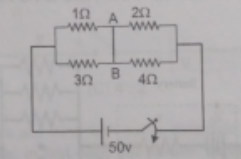A bulb is conneted to an ideal battery of emf 10 V so that the resulting current is 10 mA. When the bulb is connected to 220 V mains (ideal), the current is 50 mA. Choose the correct alternative (s)
In the first case, the resistance of the bulb is 1KΩ and in second case, it is 4.4KΩ.
It is possible since ohm's law is not followed
The increase in resistance is due to heating of the filament of the bulb when it is conneted to 220 V mains
None of these
The correct Answer is:B, C
To solve the problem step by step, we will apply Ohm's Law and analyze the given information about the bulb's behavior under different voltage conditions.
Step 1: Understand the Given Data
We have two scenarios for the bulb:
1. Connected to a 10 V battery, the current is 10 mA.
2. Connected to a 220 V mains supply, the current is 50 mA.
Step 2: Calculate Resistance in the First Case
Using Ohm's Law, which states V=I×R, we can find the resistance in the first case.
- Given:
- Voltage V1=10V
- Current I1=10mA=10×10−3A
Using the formula:
R1=V1I1=10V10×10−3A=100.01=1000Ω=1kΩ
Step 3: Calculate Resistance in the Second Case
Now, we will calculate the resistance in the second case.
- Given:
- Voltage V2=220V
- Current I2=50mA=50×10−3A
Using the formula:
R2=V2I2=220V50×10−3A=2200.05=4400Ω=4.4kΩ
Step 4: Analyze the Results
From our calculations:
- Resistance in the first case R1=1kΩ
- Resistance in the second case R2=4.4kΩ
Step 5: Conclusion
Since the resistance changes from 1 kΩ to 4.4 kΩ when the voltage changes, we conclude that the resistance is not constant. This indicates that Ohm's Law is not being followed in this scenario.
Step 6: Evaluate the Options
1. First option: Incorrect, as the resistance is not constant.
2. Second option: Correct, as Ohm's Law is not followed.
3. Third option: Correct, as the increase in resistance can be attributed to the heating of the filament when connected to a higher voltage.
Final Answer
The correct alternatives are:
- Option 2: It is possible since Ohm's law is not followed.
- Option 3: The increase in resistance is due to heating of the filament of the bulb when it is connected to 220 V mains.
---
We have two scenarios for the bulb:
1. Connected to a 10 V battery, the current is 10 mA.
2. Connected to a 220 V mains supply, the current is 50 mA.
Using Ohm's Law, which states V=I×R, we can find the resistance in the first case.
- Voltage V1=10V
- Current I1=10mA=10×10−3A
R1=V1I1=10V10×10−3A=100.01=1000Ω=1kΩ
Now, we will calculate the resistance in the second case.
- Voltage V2=220V
- Current I2=50mA=50×10−3A
R2=V2I2=220V50×10−3A=2200.05=4400Ω=4.4kΩ
From our calculations:
- Resistance in the first case R1=1kΩ
- Resistance in the second case R2=4.4kΩ
Since the resistance changes from 1 kΩ to 4.4 kΩ when the voltage changes, we conclude that the resistance is not constant. This indicates that Ohm's Law is not being followed in this scenario.
1. First option: Incorrect, as the resistance is not constant.
2. Second option: Correct, as Ohm's Law is not followed.
3. Third option: Correct, as the increase in resistance can be attributed to the heating of the filament when connected to a higher voltage.
The correct alternatives are:
- Option 2: It is possible since Ohm's law is not followed.
- Option 3: The increase in resistance is due to heating of the filament of the bulb when it is connected to 220 V mains.
Topper's Solved these Questions
- CURRENT ELECTRICITYBOOK - RESONANCE ENGLISHCHAPTER - CURRENT ELECTRICITYEXERCISE - Exercise-2 (Part-4)
12 Videos
- CURRENT ELECTRICITYBOOK - RESONANCE ENGLISHCHAPTER - CURRENT ELECTRICITYEXERCISE - Exrcies-3(PART-1)
22 Videos
- CURRENT ELECTRICITYBOOK - RESONANCE ENGLISHCHAPTER - CURRENT ELECTRICITYEXERCISE - Exercise-2 (Part-2)
16 Videos
- COMMUNICATION SYSTEMSBOOK - RESONANCE ENGLISHCHAPTER - COMMUNICATION SYSTEMSEXERCISE - Exercise 3
13 Videos
- DAILY PRACTICE PROBLEMBOOK - RESONANCE ENGLISHCHAPTER - DAILY PRACTICE PROBLEMEXERCISE - DPP.No.71
1 Video
Similar Questions
An electric bulb is connected to a 220V generator. The current is 0.50A. What is the power of the bulb ?
View SolutionWhen an inductor coil is connected to an ideal battery of emf 10V, a constant current 2.5 A flows. When the same inductor coil is connected to an ac source of 10V and 50 HZ then the current is 2A. Find out the inductance of the coil.
View SolutionHow much current will the bulb draw, if connected to a 250 V supply?
View SolutionA 100W bulb is connected to an AC source of 220V, 50Hz. Then the current flowing through the bulb is
View SolutionFour resistance are connected by an ideal battery of emf 50 volt, circuit is in steady state then the current in wire AB is :

View SolutionFor resistances are connected by an ideal battery of emf 15 V, the circuit is in steady - state then the current (in ampere) in wire AB is :

View SolutionAn electric heater rated 220 V and 550 V is connected to AC mains. The current drawn by it is
View SolutionAn electric bulb is rated '100 W, 250 V'. How much current will the bulb draw if connected to a 250 V supply ?
View SolutionA 60 watt bulb operates on 220 V supply. The current flowing through the bulb is
View SolutionAn electric bulb is rated 250 W, 230 V'. Calculate:
the time in which the bulb will consume 1.0 kWh energy when connected to 230 V mains.
View Solution